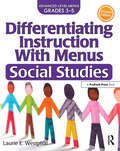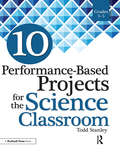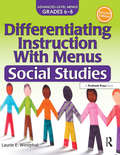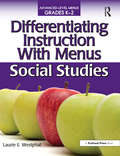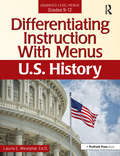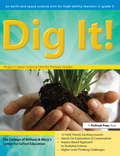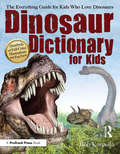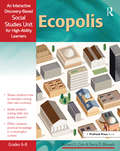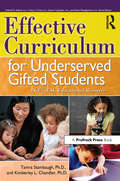- Table View
- List View
Differentiating Instruction With Menus: Math (Grades 6-8)
by Laurie E. WestphalThe best-selling Differentiating Instruction With Menus series has helped teachers nationwide differentiate instruction for their high-ability learners with easy-to-use menus and exciting tools to challenge and reach gifted and advanced students in the classroom. Each book includes an updated, student-friendly rubric that can assess different types of products, free choice proposal forms to encourage independent study, and new and favorite challenging menus to meet the needs of these diverse higher level learners. Readers will also be able to save time by using updated guidelines that reflect changes in technology for each of the products included in the menus and find direct alignment with standards approved in recent years. Topics addressed in Differentiating Instruction With Menus: Math (Grades 6-8, 2nd ed.) include numbers and operations, geometry, measurement, and basic algebra.Grades 6-8
Differentiating Instruction With Menus: Math (Grades K-2)
by Laurie E. WestphalThe Differentiating Instruction With Menus series offers teachers exciting tools to challenge and reach both gifted and advanced students in the classroom. Whether these students need enrichment, choice in independent practice, or even additional academic options resulting from curriculum compacting, these books provide teachers a complete ready-to-use resource. Each book includes a rubric that can assess different types of products, free choice proposal forms to encourage independent study, specific guidelines for each of the products included in the menus to save the teacher time, and challenging menus to meet the needs of these diverse higher level learners.Differentiating Instruction With Menus: Math (Grades K-2) contains attractive reproducible menus, based on the levels of Bloom's revised taxonomy, that students can use as a guide when making decisions about which products they will develop after they study a major concept or unit. Topics addressed include numbers and number sense, operations, geometry, and measurement.The products included on the menu are carefully selected from various learning styles to build students' excitement and so that teachers can more accurately assess the depth of what has been learned. Using creative and challenging choices found in Three-Shape Menus, Tic-Tac-Toe Menus, Meal Menus, Give Me Five Menus, 2-5-8 Menus, and List Menus, students will look forward to sharing their newfound knowledge throughout the year!Grades K-2
Differentiating Instruction With Menus: Physics (Grades 9-12)
by Laurie E. WestphalDifferentiating Instruction With Menus: Physics (grades 9-12) offers teachers everything needed to create a student-centered learning environment based on choice in the high school classroom. This book:Uses different types of menus that students can use to select exciting advanced-level products.Features attractive reproducible menus and rubrics.Is based on the levels of Bloom's revised taxonomy.Incorporates different learning styles.Makes incorporating choice into the classroom stress-free for both teachers and their students.Topics addressed include motion, forces, energy, momentum, and waves. These menus can be used to guide students in making decisions as to which products they will develop after studying a major concept or unit.Grades 9-12
Differentiating Instruction With Menus: Science (Grades 3-5)
by Laurie E. WestphalThe best-selling Differentiating Instruction With Menus series has helped teachers nationwide differentiate instruction for their high-ability learners with easy-to-use menus and exciting tools to challenge and reach gifted and advanced students in the classroom. Each book includes an updated, student-friendly rubric that can assess different types of products, free choice proposal forms to encourage independent study, and new and favorite challenging menus to meet the needs of these diverse higher level learners. Readers will also be able to save time by using updated guidelines that reflect changes in technology for each of the products included in the menus and find direct alignment with standards approved in recent years. Topics addressed in Differentiating Instruction With Menus: Science (Grades 3-5, 2nd ed.) include physical science, biological science, Earth science, and scientists and the tools they use.Grades 3-5
Differentiating Instruction With Menus: Science (Grades 6-8)
by Laurie E. WestphalThe best-selling Differentiating Instruction With Menus series has helped teachers nationwide differentiate instruction for their high-ability learners with easy-to-use menus and exciting tools to challenge and reach gifted and advanced students in the classroom. Each book includes an updated, student-friendly rubric that can assess different types of products, free choice proposal forms to encourage independent study, and new and favorite challenging menus to meet the needs of these diverse higher level learners. Readers will also be able to save time by using updated guidelines that reflect changes in technology for each of the products included in the menus and find direct alignment with standards approved in recent years. Topics addressed in Differentiating Instruction With Menus: Science (Grades 6-8, 2nd ed.) include process skills, physical sciences, life sciences, and Earth and space sciences.Grades 6-8
Differentiating Instruction With Menus: Science (Grades K-2)
by Laurie E. WestphalThe Differentiating Instruction With Menus series offers teachers exciting tools to challenge and reach both gifted and advanced students in the classroom. Whether these students need enrichment, choice in independent practice, or even additional academic options resulting from curriculum compacting, these books provide teachers a complete ready-to-use resource. Each book includes a rubric that can assess different types of products, free choice proposal forms to encourage independent study, specific guidelines for each of the products included in the menus to save the teacher time, and challenging menus to meet the needs of these diverse higher level learners.Differentiating Instruction With Menus: Science (Grades K-2) contains attractive reproducible menus, based on the levels of Bloom's revised taxonomy, that students can use as a guide when making decisions about which products they will develop after they study a major concept or unit. Topics addressed include life science, Earth science, and physical science.The products included on the menu are carefully selected from various learning styles to build students' excitement and so that teachers can more accurately assess the depth of what has been learned. Using creative and challenging choices found in Three-Shape Menus, Tic-Tac-Toe Menus, Meal Menus, Give Me Five Menus, 2-5-8 Menus, and List Menus, students will look forward to sharing their newfound knowledge throughout the year!Grades K-2
Differentiating Instruction With Menus: Social Studies (Grades 3-5)
by Laurie E. WestphalThe best-selling Differentiating Instruction With Menus series has helped teachers nationwide differentiate instruction for their high-ability learners with easy-to-use menus and exciting tools to challenge and reach gifted and advanced students in the classroom. Each book includes an updated, student-friendly rubric that can assess different types of products, free choice proposal forms to encourage independent study, and new and favorite challenging menus to meet the needs of these diverse higher level learners. Readers will also be able to save time by using updated guidelines that reflect changes in technology for each of the products included in the menus and find direct alignment with standards approved in recent years. Topics addressed in Differentiating Instruction With Menus: Social Studies (Grades 3-5, 2nd ed.) include ancient history, American history and documents, government, people, and geography.Grades 3-5
10 Performance-Based Projects for the Science Classroom: Grades 3-5
by Todd StanleyEach book in the 10 Performance-Based Projects series provides 10 ready-made projects designed to help students achieve higher levels of thinking and develop 21st-century skills. Projects are aligned to the Next Generation Science Standards, allowing students to explore and be creative as well as gain enduring understanding. Each project represents a type of performance assessment, including portfolios, oral presentations, research papers, and exhibitions. Included for each project is a suggested calendar to allow teacher scheduling, mini-lessons that allow students to build capacity and gain understanding, as well as multiple rubrics to objectively assess student performance. The lessons are presented in an easy-to-follow format, enabling teachers to implement projects immediately. Grades 3-5
Differentiating Instruction With Menus: Social Studies (Grades 6-8)
by Laurie E. WestphalThe best-selling Differentiating Instruction With Menus series has helped teachers nationwide differentiate instruction for their high-ability learners with easy-to-use menus and exciting tools to challenge and reach gifted and advanced students in the classroom. Each book includes an updated, student-friendly rubric that can assess different types of products, free choice proposal forms to encourage independent study, and new and favorite challenging menus to meet the needs of these diverse higher level learners. Readers will also be able to save time by using updated guidelines that reflect changes in technology for each of the products included in the menus and find direct alignment with standards approved in recent years. Topics addressed in Differentiating Instruction With Menus: Social Studies (Grades 6-8, 2nd ed.) include U.S. history, government, people, and geography.Grades 6-8
Differentiating Instruction With Menus: Social Studies (Grades K-2)
by Laurie E. WestphalThe Differentiating Instruction With Menus series offers teachers exciting tools to challenge and reach both gifted and advanced students in the classroom. Whether these students need enrichment, choice in independent practice, or even additional academic options resulting from curriculum compacting, these books provide teachers a complete ready-to-use resource. Each book includes a rubric that can assess different types of products, free choice proposal forms to encourage independent study, specific guidelines for each of the products included in the menus to save the teacher time, and challenging menus to meet the needs of these diverse higher level learners.Differentiating Instruction With Menus: Social Studies (Grades K-2) contains attractive reproducible menus, based on the levels of Bloom's revised taxonomy, that students can use as a guide when making decisions about which products they will develop after they study a major concept or unit. Topics addressed include culture and citizenship, geography, government, history, and people and places.The products included on the menu are carefully selected from various learning styles to build students' excitement and so that teachers can more accurately assess the depth of what has been learned. Using creative and challenging choices found in Three-Shape Menus, Tic-Tac-Toe Menus, Meal Menus, Give Me Five Menus, 2-5-8 Menus, and List Menus, students will look forward to sharing their newfound knowledge throughout the year!Grades K-2
Differentiating Instruction With Menus: U.S. History (Grades 9-12)
by Laurie E. WestphalDifferentiating Instruction With Menus: U.S. History (grades 9-12) offers teachers everything needed to create a student-centered learning environment based on choice in the high school classroom. This book:Features attractive reproducible menus and rubrics.Is based on the levels of Bloom's revised taxonomy.Incorporates different learning styles.Makes incorporating choice into the classroom stress-free for both teachers and their students.Topics addressed include history, geography, economics, government, and culture. Ideal for differentiating for gifted and advanced learners, these menus can be used to guide students in making decisions as to which products they will develop after studying a major concept or unit.
Differentiation Made Simple: Timesaving Tools for Teachers
by Mary Ann CarrDifferentiation is a practice that is beneficial to every student. Rather than focusing on leaving no child behind, differentiation aims to move every child ahead. The trouble for many teachers is, however, that differentiating for all students can be time consuming. Differentiation Made Simple will help classroom teachers overcome time constraints and other obstacles to differentiation by providing a wealth of ready-made and generic tools they can employ right away. The tools include task cards for literature, creative writing, and research; tic-tac-toe menus; graphic organizers; and guides to creating differentiated units—each one tied to specific questions and concerns teachers have about differentiating instruction. Also included are product lists and other assessment ideas, including rubrics and a scoring conversion table. Written especially for teachers in the trenches, Differentiation Made Simple will help unlock the door to creating a classroom where every child is challenged by work appropriate for his or her abilities, interests, and learning styles.
Differentiation That Really Works: Language Arts (Grades 6-12)
by Cheryll M. Adams Rebecca L. PierceDifferentiation That Really Works: Language Arts provides time-saving tips and strategies from real teachers who teach language arts in grades 6-12. These teachers not only developed the materials and used them in their own classes, but they also provided useful feedback and comments about the activities. The strategies included in the book are tiered lessons, cubing, graphic organizers, exit cards, learning contracts, and choice boards. Every strategy includes directions and offers opportunities for differentiation.Grades 6-12
Differentiation That Really Works: Math (Grades 6-12)
by Cheryll M. Adams Rebecca L. PierceDifferentiation That Really Works: Math (6-12) provides time-saving tips and strategies from real teachers who teach math in grades 6-12. These teachers not only developed the materials and used them in their own classes, but they also provided useful feedback and comments about the activities. The strategies included in the book are tiered lessons, cubing, graphic organizers, exit cards, learning contracts, and choice boards. Every strategy includes directions and offers opportunities for differentiation.Grades 6-12
Differentiation That Really Works: Science (Grades 6-12)
by Cheryll M. Adams Rebecca L. PierceDifferentiation That Really Works: Science provides time-saving tips and strategies from real teachers who teach science in grades 6-12. These teachers not only developed the materials and used them in their own classes, but they also provided useful feedback and comments about the activities. The strategies included in the book are tiered lessons, cubing, graphic organizers, exit cards, learning contracts, and choice boards. Every strategy includes directions and offers opportunities for differentiation.Grades 6-12
Differentiation That Really Works: Strategies From Real Teachers for Real Classrooms (Grades 3-5)
by Cheryll M. Adams Rebecca L. PierceDifferentiating requires more than just a simple bag of tricks. Teachers need to have concrete strategies if they want to provide choice and challenge for all learners in their classroom. The strategies included in this book were chosen based on their ease of implementation and modification. In addition, they all encourage student engagement, provide inherent opportunities for differentiation, and are appropriate for multiple grade levels.Differentiation That Really Works provides time-saving strategies and lesson ideas created and field-tested by practicing professionals in their own heterogeneous classrooms. These lessons can be used as written or can be modified to meet the needs of a particular classroom. The book also provides templates that can be used to develop new lessons using each strategy. These strategies, including exit cards, choice boards, cubing, graphic organizers, learning contracts, and tiered lessons, help pave the way to a differentiated classroom that meets all students' needs!Grades 3-5
Differentiation That Really Works: Strategies From Real Teachers for Real Classrooms (Grades K-2)
by Cheryll M. Adams Rebecca L. PierceDifferentiating requires more than just a simple bag of tricks. Teachers need to have concrete strategies if they want to provide choice and challenge for all learners in their classroom. The strategies included in this book were chosen based on their ease of implementation and modification. In addition, they all encourage student engagement, provide inherent opportunities for differentiation, and are appropriate for multiple grade levels.Differentiation That Really Works provides time-saving strategies and lesson ideas created and field-tested by practicing professionals in their own heterogeneous classrooms. These lessons can be used as written or can be modified to meet the needs of a particular classroom. The book also provides templates that can be used to develop new lessons using each strategy. These strategies, including exit cards, choice boards, cubing, graphic organizers, learning contracts, and tiered lessons, help pave the way to a differentiated classroom that meets all students' needs!Grades K-2
Dig It!: An Earth and Space Science Unit for High-Ability Learners in Grade 3
by Clg Of William And Mary/Ctr Gift EdDig It!, a third-grade Earth and space science unit, encourages students to investigate humanity's effects on the environment and the importance of conserving natural resources. The unit builds upon students' prior knowledge and the overarching concept of change by providing opportunities to relate local examples of environmental pollution and conservation with hands-on scientific experiments and demonstrations.Dig It! was developed by the Center for Gifted Education at The College of William and Mary to offer advanced curriculum supported by years of research. The Center's materials have received national recognition from the United States Department of Education and the National Association for Gifted Children, and they are widely used both nationally and internationally.Each of the books in this series offers curriculum that focuses on advanced content and higher level processes. The science units contain simulations of real-world problems, and students experience the work of real science by using data-handling skills, analyzing information, and evaluating results. The mathematics units provide sophisticated ideas and concepts, challenging extensions, higher order thinking skills, and opportunities for student exploration based on interest. These materials are a must for any teacher seeking to challenge and engage learners and increase achievement.Grade 3
Dinosaur Dictionary for Kids: The Everything Guide for Kids Who Love Dinosaurs
by Bob KorpellaPacked with hundreds of illustrated definitions about dinosaurs and the world in which they lived, Dinosaur Dictionary for Kids is certain to spark any kid's enthusiasm for the age of dinosaurs. Explore the Mesozoic era. Learn about dinosaurs that lived on land, animals that swam the waters, and species that patrolled the skies. Find out about dinosaur extinction, how scientists date fossils, and what it takes to become a paleontologist. Dinosaur Dictionary for Kids will be there when it's time to write reports, delve into projects, prepare assignments, or just curl up and discover more about these amazing creatures. Sidebar topics, fun activities, and quick quizzes make learning about dinosaurs even more fun! Divided into sections for quick access to the easy-to-understand definitions and amazing full-color illustrations, Dinosaur Dictionary for Kids is a must-have for any kid's home library.Grades 3-6
DownWRITE Funny: Using Students' Love of the Ridiculous to Build Serious Writing Skills (Grades 7-12)
by Randy LarsonDownWRITE Funny teaches all kinds of good “stuff” about writing but in an unusual way—by appealing to young people's love of the ridiculous. Using an unusual blend of zany illustrations and “out there” writing assignments, the author leads students through a wide range of lessons and activities that will help them become better writers.Subjects range from the basic (avoiding sentence fragments and run-ons), to the practical (using transitions), to the more advanced (writing in active voice). All activities include wonderfully challenging and funny writing assignments that will stretch students' minds and help them learn important lessons about writing.Grades 7-12
Dumbing Down America: The War on Our Nation's Brightest Young Minds
by James R. DelisleAt a time when the U.S. education system consistently lags behind its international peers, Dumbing Down America shows exactly why America can't keep up by providing a critical look at the nation's schools through the eyes of the children whose minds are languishing in countless classrooms. Filled with specific examples of how gifted children are being shortchanged by a nation that believes smart kids will succeed on their own, Dumbing Down America packs a powerful message: If we want our nation to prosper, we must pay attention to its most intelligent youth. With more than 35 years of experience working with and for gifted children, author James R. Delisle provides a template of what can and must happen in America's schools if they are to fulfill their mission of educating every child to the fullest potential. Dumbing Down America is a must-read for any individual who believes that the unfulfilled promises to gifted children must begin to be met in America's schools today, not someday.
Ecopolis: An Interactive Discovery-Based Social Studies Unit for High-Ability Learners (Grades 6-8)
by Richard Cote Darcy BlauveltThe Interactive Discovery-Based Units for High-Ability Learners, for grades 6-8, provide teachers with opportunities to use exciting and challenging units in their classrooms. These engaging curriculum units culminate in authentic performance platforms that provide students with open-ended opportunities to demonstrate academic understanding. Each book in the series contains tiered lessons that teachers can easily modify to meet individual students' needs. Ecopolis has students run their own government to learn about issues including scarcity, resource allocation, needs vs. wants, opportunity costs, entrepreneurship, and global interdependence.
Educating Gifted Students in Middle School: A Practical Guide
by Susan RakowEducating Gifted Students in Middle School: A Practical Guide (3rd ed.) helps educators with the challenging task of understanding and meeting the needs of gifted students in middle school. This revised and updated third edition:Provides a rationale and framework that middle schools can use to fill the service gap for gifted and advanced learners.Addresses the needs of learners from diverse backgrounds.Shows how to implement effective program models.Identifies best practices for the classroom.Shares research-based curriculum models.Topics addressed include school organization, instructional strategies in the basic subject areas, cocurricular and summer programs, the missing link of executive function skills, and counseling at-risk gifted learners. Educating Gifted Students in Middle School focuses on creative, practical, and realistic school solutions that create a vital and responsive community for all students.
Achieving Equity in Gifted Programming: Dismantling Barriers and Tapping Potential
by April WellsAchieving Equity in Gifted Programming offers practical, research-based programming implementations to increase equity in gifted education and:
Effective Curriculum for Underserved Gifted Students: A CEC-TAG Educational Resource
by Tamra Stambaugh Kimberley ChandlerEffective Curriculum for Underserved Gifted Students explains the need for a differentiated curriculum for gifted students typically underrepresented in gifted programs, including children of poverty and those who are from culturally and linguistically diverse populations. Features of research-based curriculum found to be effective in enhancing the academic achievement of these populations are highlighted. In addition, practical, evidence-based strategies for curriculum development and instruction are shared.






